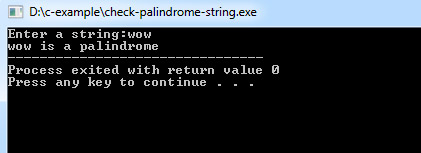A palindrome is a string, which is the same when read in both forward and backward ways. Identifying such unique strings has applications in data analysis, algorithms, and more. This tutorial guides you through writing a C program to determine if a given string is a palindrome.
Examples of Palindromes:
Popular examples include 'radar,' 'madam,' 'pop,' and 'lol.'
How to Write a C Program for Palindrome String Check
Here's a concise, well-commented C code snippet that effectively identifies whether a given string is a palindrome or not.
Example:
#include <stdio.h>
#include <string.h>
int main() {
char string1[20];
int i, length;
int flag = 0;
// Prompt the user for input
printf("Enter a string: ");
scanf("%s", string1);
// Calculate the string length
length = strlen(string1);
// Compare characters from the start and end of the string
// and stop if a mismatch is found or the middle of the string is reached.
for (i = 0; i < length / 2; i++) {
if (string1[i] != string1[length - i - 1]) {
flag = 1;
break;
}
}
// Output the result
if (flag) {
printf("%s is not a palindrome\n", string1);
} else {
printf("%s is a palindrome\n", string1);
}
return 0;
}Program Output:

Detailed Explanation:
The above program compares the characters of the string from the beginning and end and stops if a mismatch is found or the middle of the string is reached. If all of the characters match, then the string is a palindrome.
Consider the string "radar". Its character comparison would be as follows:
---------------------------
index: 0 1 2 3 4
value: r a d a r
---------------------------

To compare it with the reverse of itself, the following logic is used:
- The 0th character in the char array, string1, is the same as the 4th character in the same string.
- 1st character is the same as 3rd character.
- 2nd character is the same as 2nd character.
- . . . .
- ith character is the same as the 'length-i-1'th character.
- If any of the above conditions fails, the flag is set to true(1), implying that the string is not a palindrome.
- By default, the value of the flag is false(0). Hence, the string is a palindrome if all the conditions are satisfied.